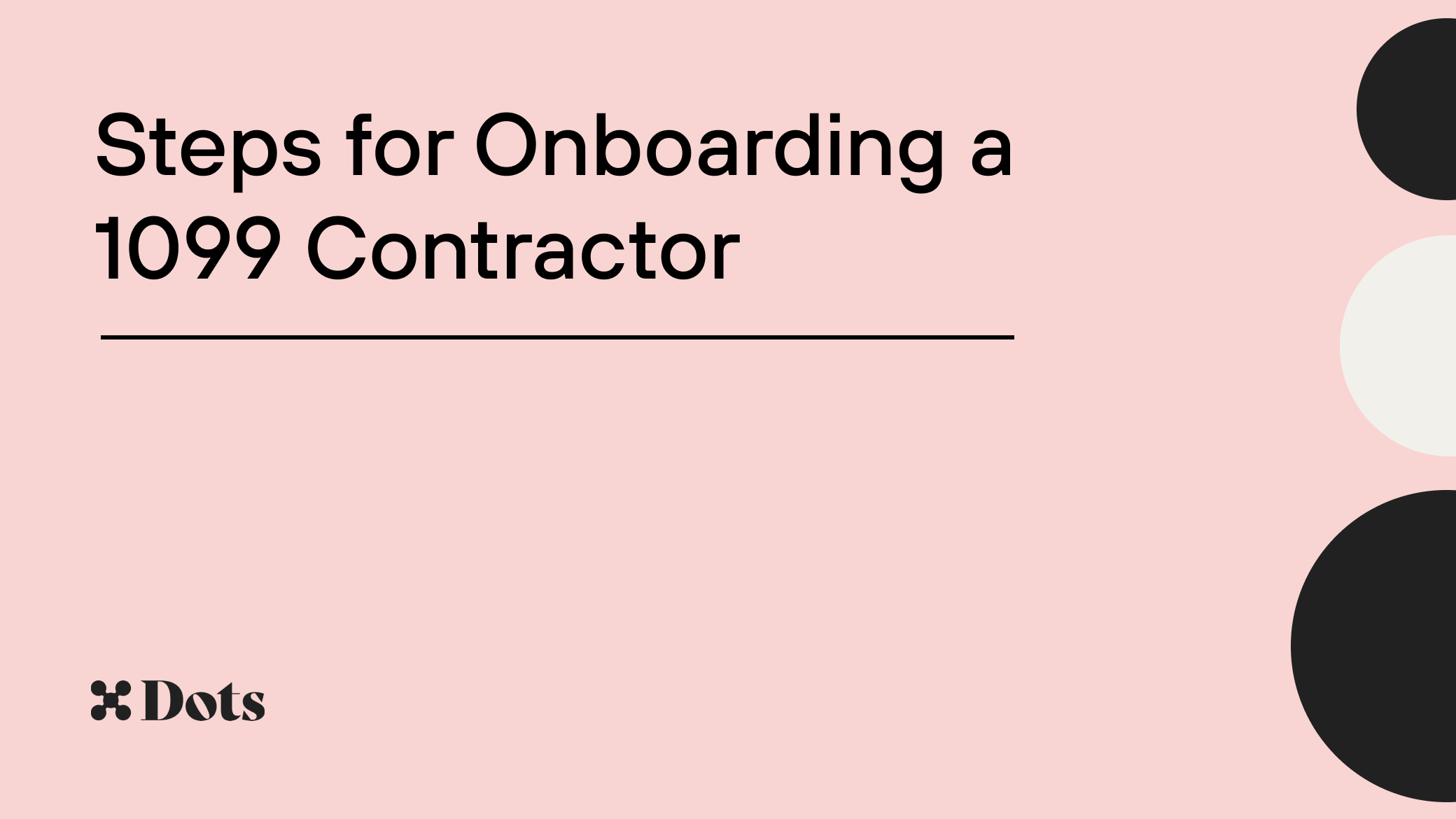Steps for Onboarding a 1099 Contractor

Are you a business that needs to onboard 1099 contractors? This can be a tricky process, but it doesn’t have to be that way. In this blog, we’ll provide you with a step-by-step guide on how to successfully onboard 1099 contractors as efficiently and effectively as possible. Onboarding requires proper compliance, understanding of 1099 contractors and more, but we’ll cover everything you need to know.
Ready to learn more? Read on or schedule a demo with Dots to automate compliance and tax reporting for 1099 payouts.
What is a 1099 Contractor?
First, let’s define 1099 contractors. A 1099 contractor is a freelancer, independent contractor or other types of self-employed individual who is not an employee of a business. To report their taxes, these individuals receive Form 1099-MISC from the businesses they work with. Since 1099 contractors are responsible for their own taxes and benefits, businesses don’t have to pay benefits or cover a portion of their taxes as they do with regular employees.
1099 contractors will work with businesses by establishing a contract, which sets an agreed-upon rate for the contractor and outlines the services they’ll be providing to a business. 1099 contractors will typically work with multiple businesses and are often hired on a project-by-project basis. A 1099 worker’s contract will also typically outline how much time they’ll spend on a project or what work they’ll be completing for the project.
What Are the Benefits of Hiring Them?
Hiring a 1099 contractor can be beneficial in numerous ways. Let’s take a look at some of the top benefits a business gets from working with a 1099 contractor:
- Cost-saving - One of the primary benefits of hiring a 1099 contractor is the money they can save you. A 1099 contractor can provide the extra work you need for a project without having to hire a new employee, onboard them, train them, and pay them a salary with benefits. The cost of paying the contractor is usually far less than the cost of taking on a new employee.
- Access to skills - Sometimes a business will need certain special skills to complete a project that their regular staff doesn’t possess. If you don’t normally need a role or position for these skills, a 1099 contractor can fill the role for that specific project. This way you don’t have to hire for a role that your business doesn’t typically need.
- Scalability - When your business is growing rapidly and you have big projects to take on, you may not have the money or resources to hire staff to cover the added workload. 1099 contractors are a quick and skilled source or work that can cover this added workload without putting extra strain on your current staff.
- Simplicity - 1099 contractors aren’t your direct employees, so there are fewer legalities and complications. This gives you flexibility with how you use them. Since contractors only expect to work with you for the duration of a contract, you can simply stop working with them after it's over. There’s no need to fire them or deal with any potential unemployment issues. Additionally, you can call upon the skills and work with trusted contractors in the future when you need them.
These are just some of the benefits of working with 1099 contractors. You should consider these advantages when deciding if 1099 contractors make sense for your business.
What Documents Do I Need?
When you’re onboarding a 1099 contractor, you’re going to need a few different documents. One document you’ll need is the contract itself, which outlines the terms and conditions of the job. This should tell the contractor the services they need to complete, their rate of pay, hours expected, deadlines and any other pertinent details. The contract should also include details like confidentiality clauses and non-compete agreements if applicable. Confidentiality clauses, or non-disclosure agreements, ensure the contractor doesn’t share any information you deem as restricted or sensitive. Non-compete agreements state that a contractor can’t work for competitors for a certain duration.
You will also need several tax documents when onboarding a contractor. Here are the important tax forms to know:
- W-9 Form - A W-9 form verifies the identity of the contractor and their eligibility to work for you. These forms include name, current address and TIN (tax identification number. If you’re working with an international contractor, you’ll need a W-8BEN instead.
- 1099-MISC - Contractors will also need a 1099-MISC form, which must be issued to freelancers if they’ve been paid $600 or more to provide services to your business.
Here are some important deadlines you should also know about these forms:
- January 31 - Businesses need to send out 1099-MISC forms to contractors by the end of January.
- February 28 - Copies of 1099 MISC forms issued to contractors must be submitted to the IRS by the end of February.
While the documents needed for contractors aren’t overly complex, it’s important to accurately collect and report them to avoid fines and penalties.
Now that we’ve covered the necessary paperwork you’ll need, let’s dive into the best way to onboard your contractor. You’ll want to give them everything they need and make them feel comfortable so they can hit the ground running.
1. Have Them Meet Their Point of Contact
The first important step for onboarding a 1099 contractor is introducing them to their point of contact. This will be who they report to throughout the duration of the contract. Ensuring they meet their point of contact will ensure communications go smoothly and they’ll have someone to go to with questions from the start. This is especially important for contractors who are working remotely, as they’ll know exactly who they need to get in touch with.
Their point of contact will make sure they get everything they need and provide them with a quick introduction to the company and the project they’ll be working on. They should establish expectations and give the contractor the information they need to contact them. They should also make sure they have the correct information for the contractor and the best way to communicate with them.
At this point, contractors should also be introduced to other team members they may be working with or collaborating with. This helps facilitate a positive working relationship and makes sure everyone is on the same page.
2. Ensure They Have Access to All the Right Tools
Remember, contractors aren’t regular employees, so they’ll only have their usual tools of the trade available to them. If they need access to special software or other tools to complete the project, you’ll want to get the setup at this point. Make sure to set them up with an account and log in so they can access the tools and applications they need to access.
Most software solutions and applications have access restriction settings, so you should make sure you’ve set these to ensure your contractors can only access the information and tools they need to complete the job. Make sure they’re also set up with any training guide or resources they may need to use the tools and software if they’re unfamiliar with it.
Ensuring they have access to these resources from the beginning ensures they can start working on the project as soon as possible, and the process isn’t bottlenecked by administrative issues.
3. Set Up a Communication Channel
It’s essential to set up a reliable communication channel between your 1099 contractor and anyone else they need to collaborate with to complete their work. You likely already have a communication channel and project management software that your team uses, so make sure they’re set up and comfortable with using those platforms.
Provide them with clear onboarding instructions so they can get set up on these communication channels as soon as possible. Also, make sure to outline how these channels are used so they can seamlessly join the team and communicate efficiently.
Make sure the contractor understands the responsibilities of team members, so they know who to reach out to with questions and problems. For instance, they should know who is in charge of accounting for getting paid, who is the project lead, etc. This ensures they don’t waste their time or the time of your team members, trying to find the person to talk to.
4. Consider Confidentiality and Non-Compete Agreements
As mentioned, you’ll want to consider confidentiality and non-compete agreements when onboarding a contractor. While these aren’t technically necessary, you’ll want to consider if they make sense for your business. If your contractor has access to sensitive company data or information that is proprietary, you’ll want to ensure they have a confidentiality agreement in place. This prevents them from sharing the information with third parties or using the information to their own benefit.
Since contractors often work for multiple companies, you may also want to consider a non-compete agreement. This ensures they won’t be working for any of your competitors during the project and for a certain amount of time after the contractor closes.
5. Clearly Outline Their Responsibilities
One of the most important steps of onboarding a contractor is making sure they clearly understand their responsibilities. This will set the tone for the contract and ensure that they know what is expected of them. These expectations and responsibilities should be very clearly stated and outlined so there is no room for ambiguity. Here are some points you’ll want to include:
• The specific tasks the contractor will be performing
• The exact timeline and deadlines they will need to meet
• Any additional resources they might need access to
By providing your contractor with this information from the beginning, you’ll help ensure your contractor can successfully complete the job and provide quality results.
6. Establish Payout Guidelines and Expectations
Of course, your contractor will need to get paid, transparently and on time. . You should make sure to clearly establish your payout guidelines so contractors understand how and when they’ll get paid.
Here are some guidelines you should outline:
- Payment rate - First, you’ll need to establish how much you’ll be paying your contractor. Contractors typically work at a flat rate for the entire contract or an hourly rate.
- Payment schedule - Outline when payments will be made. This could be a lump sum at the end of the project, regular recurring payments throughout the project, or whatever other schedules you and the contractor agree on.
- Payment method - There are many ways to pay a contractor. You could pay them through direct bank transfers, checks, payment processors or other digital payment methods.
If you’re looking for a simple and convenient way to offer your contractors multiple payout options, Dots can help.
Make Contractor Payouts Easy With the Dots API
Onboarding a contractor can sometimes be complicated, but you can make it much simpler with Dots. With the Dots API, you can automate your payout process. With Dots, you can provide your contractors with multiple payout options, send out payouts automatically, automate compliance, automate tax form collection, and automatically track payouts in your accounting software. Ready to learn more? Schedule your demo with Dots today.
